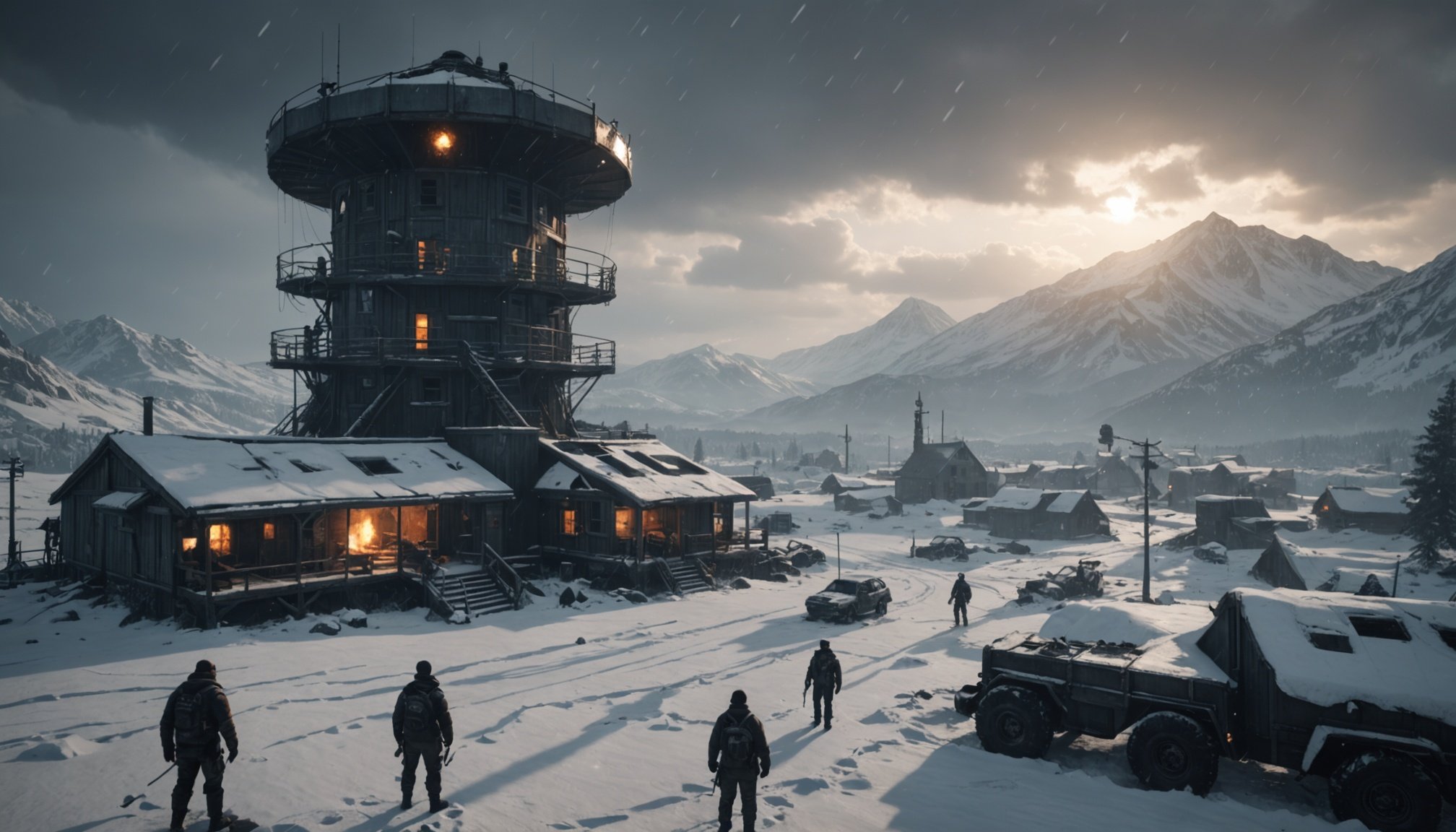Revolutionizing Survival Games: The Impact of AI-Powered Dynamic Weather Effects on Gameplay and Strategy
The Evolution of Dynamic Weather in Gaming
Dynamic weather effects have long been a staple in the gaming industry, but the recent advancements in artificial intelligence (AI) and machine learning (ML) have taken these effects to a whole new level. In modern survival games, dynamic weather is no longer just a visual enhancement; it has become a crucial element that influences gameplay mechanics, strategy, and overall player engagement.
For instance, in games like S.T.A.L.K.E.R. 2: Heart of Chornobyl, the dynamic weather system is integrated seamlessly into the game world. The game features a day-night cycle and dynamic weather that affects not only the visuals but also the behavior of enemies and the player’s survival mechanics. This means that players must adapt their strategies based on the weather conditions, such as reduced visibility during heavy rain or increased danger during radioactive storms known as “Emissions”[1][4].
In parallel : Crafting true-to-life sand and desert scenes: proven techniques for adventure game creators
How AI and Machine Learning Enhance Weather Effects
The use of AI and ML in creating dynamic weather effects is a game-changer. Here are some key techniques and their impacts:
Convolutional Neural Networks (CNNs)
CNNs are instrumental in simulating intricate weather patterns. By training on large datasets of weather images, these networks can recognize and replicate various atmospheric conditions with impressive accuracy. This allows for realistic transitions between different weather states, enhancing the immersion and realism of the game world[2].
Have you seen this : Revving up realism: key components for building genuine damage models in racing simulations
Reinforcement Learning
Reinforcement learning enables the weather system to adapt and respond dynamically, much like learning through trial and error. This technique allows the game to modify weather conditions in real-time, ensuring that the weather feels unpredictable and lifelike. For example, a sudden rainstorm can change the visibility and movement speed of both the player and enemies, requiring immediate adjustments in strategy[2].
Impact on Gameplay and Strategy
Dynamic weather effects powered by AI and ML significantly alter the gameplay experience in several ways:
Player Engagement and Adaptation
Dynamic weather compels players to adapt their strategies in real-time. Here are a few ways this impacts gameplay:
- Visibility and Movement: Weather conditions like fog, rain, or snow can reduce visibility, making navigation and combat more challenging. Players must adjust their movement and combat tactics accordingly.
- Resource Management: In survival games, weather can affect the availability and usability of resources. For example, rain might make it easier to find water but harder to start a fire.
- Enemy Behavior: AI-driven enemies can change their behavior based on the weather. For instance, enemies might be more aggressive during a storm or more cautious in clear weather[1][4].
Realism and Immersion
Realistic weather effects enhance the player’s emotional and psychological connection to the game world. Here’s how:
- Atmospheric Sound Design: The sound of rain, wind, or thunder can create a haunting atmosphere, making the game world feel more alive and immersive.
- Visual Realism: Advanced weather effects can make the game environment look more realistic, with detailed animations and lighting that mimic real-world weather conditions.
- Environmental Hazards: Weather can introduce additional hazards such as flooding, landslides, or radioactive storms, adding a layer of unpredictability and danger to the game world[2][4].
Examples from Recent Games
Several recent games exemplify the impact of AI-powered dynamic weather effects on gameplay and strategy.
S.T.A.L.K.E.R. 2: Heart of Chornobyl
In S.T.A.L.K.E.R. 2, the dynamic weather system is deeply integrated into the game’s survival mechanics. The game’s world, set in the Chornobyl Exclusion Zone, features a dynamic ecosystem where weather affects everything from the behavior of mutants to the availability of resources. For example, the “Emissions” – deadly radioactive storms – can suddenly appear, forcing players to seek immediate shelter or face certain death[1][4].
Other Notable Games
- Alien: Isolation: While not primarily focused on weather, the game’s use of AI to create a dynamic and adaptive alien enemy is a great example of how AI can enhance gameplay. The alien’s behavior changes based on the player’s actions, creating a highly immersive and suspenseful experience[3].
- Middle-earth: Shadow of Mordor: This game features a procedural generation system that includes dynamic weather, affecting the behavior of enemies and the player’s strategy. The game’s Nemesis System, powered by AI, ensures that each playthrough is unique, with enemies adapting to the player’s actions over time[3].
Practical Insights and Actionable Advice for Developers
For game developers looking to incorporate AI-powered dynamic weather effects into their games, here are some practical insights and actionable advice:
Use of Machine Learning Algorithms
- Train on Real-World Data: Use real-world weather data to train your machine learning models. This ensures that the weather patterns in your game are realistic and varied.
- Implement Reinforcement Learning: Allow your weather system to adapt in real-time using reinforcement learning. This will make the weather feel more dynamic and unpredictable.
Integration with Game Mechanics
- Tie Weather to Resource Management: Make weather conditions affect the availability and usability of resources. For example, rain could make water more abundant but harder to find food.
- Influence Enemy Behavior: Use AI to make enemies behave differently based on the weather. This adds a layer of realism and unpredictability to the game.
Enhancing Player Engagement
- Create Immersive Atmosphere: Use sound design and visual effects to create an immersive atmosphere that changes with the weather.
- Encourage Adaptive Strategies: Design the game to require players to adapt their strategies based on the weather. This keeps the gameplay fresh and challenging.
Table: Comparison of Dynamic Weather Effects in Recent Survival Games
| Game | Dynamic Weather Effects | Impact on Gameplay | Realism and Immersion |
|---|---|---|---|
| S.T.A.L.K.E.R. 2 | Day-night cycle, Emissions, rain, snow | Affects enemy behavior, resource availability, visibility | High realism, immersive atmosphere[1][4] |
| Alien: Isolation | Limited dynamic weather | Focuses on adaptive enemy AI | High immersion due to adaptive AI[3] |
| Middle-earth: Shadow of Mordor | Procedural generation including weather | Affects enemy behavior, player strategy | High realism, unique playthroughs[3] |
| Zeverland | Seasonal changes, dynamic weather | Affects resource management, group quests | High realism, dynamic challenges[5] |
Future Trends in Game Realism and Weather Simulation
As the gaming industry continues to evolve, we can expect even more sophisticated use of AI and ML in game development. Here are some future trends to look out for:
Advanced AI and ML Technologies
- Predictive Analytics: Future games will use predictive analytics to learn from player behavior and adapt the game world accordingly. This could include more realistic weather patterns that change based on the player’s actions.
- Realistic Simulations: AI will enable more realistic simulations of complex systems like weather, making in-game environments even more immersive and dynamic.
New Gaming Genres
- Survival in Natural Disasters: Games that focus on survival in natural disasters could become more popular, with dynamic weather playing a central role in gameplay and strategy.
- Environmental Adventure Games: Adventure games deeply tied to environmental shifts could emerge, where players must navigate and adapt to changing weather conditions as part of the narrative and gameplay[2].
The integration of AI-powered dynamic weather effects in survival games is revolutionizing the gaming experience. By enhancing realism, immersion, and player engagement, these effects are setting a new standard for game development. As technology continues to advance, we can expect even more innovative uses of AI and ML in creating dynamic and unpredictable game worlds that challenge and captivate players like never before.
In the words of the developers of S.T.A.L.K.E.R. 2: Heart of Chornobyl, “The game’s chilling sound design, incredible storytelling, and demanding combat come together to deliver on that central premise” of creating a truly immersive and realistic survival horror experience. This is just the beginning of what AI and ML can achieve in the world of gaming, and it’s an exciting time for both developers and players alike[4].











